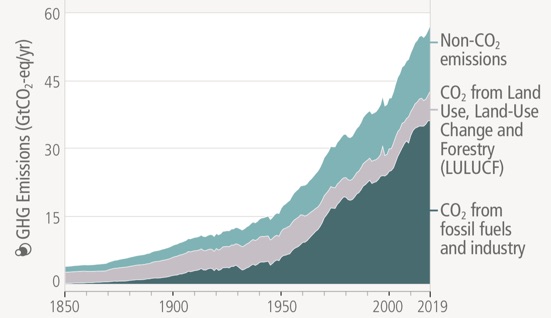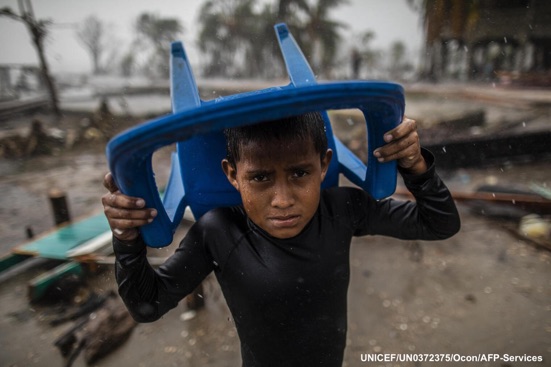News
23 November 2023
Climate: global concern and inaction, as COP 28 Dubai is at hand
The 28th Conference of Parties (COP) on climate change will be held in Dubai from November 30 to December 12, 2023. Organized by a country, the United Arab Emirates, symbol of fossil fuel extraction, and chaired by the CEO of the Abu Dhabi National Oil Company and current minister for Industry and Technologies, COP28 could not take place under more ominous circumstances.
Indeed, all indicators are in the red, as illustrated by an avalanche of reports, each of them more a source of concern than the other. They tell us that humanity has not yet fully realized the importance of the already ongoing climate crisis. Neither has it taken the required steps to reduce its magnitude and prevent its dramatic consequences.
Global greenhouse gas (GHG) emissions continue to grow
To stop the world average temperature from reaching more than 2° C above the pre-industrial level (minimum commitment taken during COP21 held in Paris in 2015), global GHG emissions should decrease at an average annual rate of 6%.
However, the 2023 IPCC report shows that these emissions continued to grow at the solid pace of 2.26% between 1990 and 2019 (last year for which data are available) [read pp. 2-4 and see Figure 1 below].
Figure 1 Evolution of GHG emissions resulting from human activities between 1850 and 2019

Source: IPCC, 2023
In 2023, global average temperature is expected to beat a 125,000-year-old record!
Early November, the World Meteorological Organization (WMO) announced that it was practically certain than 2023 would be the hottest years since temperature have been systematically recorded, “because of heat records measured on the surface of the globe (both for emerged land and oceans) since the month of June”. WMO adds: “Next year could even be hotter” [read]. In France, for example, 2023 is bound to be another anomaly that will confirm what had already been recorded in 2022 [read].
As for the Deputy director of Copernicus, the Group of Experts of the European Union on Climate Change, she declared that it is very likely that 2023 will be the hottest year in … 125,000 years!!
On the other hand, the Secretary General of the UN went one step further by stating that the current path, if it continues, is set to lead us straight to an increase of global average temperature somewhere between 2.5 °C and 2.9 °C by 2100!
2023, a year full of extreme meteorological events
Extreme meteorological events were recorded throughout the world during 2023. Here are a few examples:
-
•In January, in the US, rain and snow at the beginning of the year, in the western part of the country (21 killed) and frequent and violent tornadoes in the centre of the country.
-
•In March, dreadful cyclone Freddy kills 400 people in Mozambique and Malawi.
-
•In April, extreme heat wave in Asia (Bangladesh, India, Laos and Thailand) and in the Mediterranean region (Morocco and Spain).
-
•In May/June, mega-fires in Canada with disastrous impact on the quality of air in a large part of the north of the US. Hundreds of victims from Mocha cyclone in Myanmar and Pakistan, as well as many deaths due to heat in India.
-
•In July, heat waves on the whole of Eurasia and the US, making numerous casualties.
-
•In August, the worse natural disaster in the history of Slovenia, floods causing amazing destruction.
-
•In October, several violent storms hit northern Europe.
-
•In November in Somalia and Kenya, catastrophic floods killed people and displaced close to a million people.
Together, these events resulted in incredible damage, affecting lives of large numbers of people, testing capacity of insurance companies and requiring mobilization of considerable financial, material and human resources by the countries concerned.
Negative consequences for food production
Meteorological events had spectacular impacts on food production.
A report by the European Parliament stresses the particularly negative consequences of heat waves and drought. They can stop flowering and prevent grain formation, and cause considerable setbacks in productivity. They can also bring about high mortality among livestock [read].
In its report on the future of food [read], the FAO lists consequences of climate change for agricultural and food production. They include, inter alia:
-
•Greater difficulty of agricultural work and threats on agricultural workers’ health;
-
•Change in nutritional composition of food, due to the higher concentration of CO2 in the air;
-
•Greater risks during food conservation, as temperature rises;
-
•Lower crop and pasture yields, need to change varieties and species of plants grown and of animals reared as the climate changes, as they are no more adapted to new conditions.
-
•Increase of pests and diseases, and arrival of new pest species and new diseases for plants as well as for animals;
-
•Disruption of pollination as the cycle of plants and pollinators may not be well synchronized any more;
-
•Similar consequences can also be observed in the case of forests and aquatic systems.
Taken together, these effects could lead, with time, to a reduced availability of food and to higher prices of agricultural commodities and food products [read pp. 311-314].
Climate-related migrations are ongoing
The World Development Report, 2023 by the World Bank [read] claims that climate change will induce considerable population movements. It writes (on p. 2) that “Climate change is compounding the economic drivers of migration”, emphasizing that “About 40 percent of the world’s population – 3.5 billion people – live in places highly vulnerable to the impacts of climate change: water shortages, drought, heat stresses, sea-level rise, and extreme events such as floods and tropical cyclones.” It adds that “Climate impacts are threatening the habitability of entire regions in parts of the world as diverse as the Sahel, low-lying Bangladesh, and the Mekong Delta”, not forgetting small islands where the issue of relocations of population has become real.
UNICEF also notes that, in 6 years, around 43.1 million children had to move away from home because of meteorological disasters or 20,000 children per day! - 95% of them due to floods or storms [read]

Combatting climate change: all indicators but one are in the red
Although there are ample proofs of an ongoing disaster that is likely to be amplified to reach unprecedented levels, and although the narratives of some responsible political leaders begin to show signs of awareness of the seriousness of the situation, humanity seems incapable to take the measures required to avoid the worse.
That is that the World Resources Institute (WRI) report on the State of Climate Action 2023 indicates, based on the analysis of 42 indicators [read].
The authors of the report found that only one of these many indicators (the share of electric vehicles in passenger car sales) is on track for achieving its objective by 2030!
For all other indicators, trends show very insufficient action. For instance, “coal needs to be phased out of electricity generation seven times faster than recent rates”, while “annual rate of deforestation … needs to be reduced four times faster”.
They console themselves by noting some positive trends, such as, for example, the acceleration by one third of the speed of development of renewable (solar and wind) energy production, and the fall by 30% of the rate of deforestation in Brazil during the six first months of President Lula’s mandate.
In the field of food and agriculture, on the 6 indicators selected by WRI, only one is evolving in the right direction, but not fast enough (ruminant meat productivity in kg/ha), three progress much too slowly (GHG emissions intensity of agricultural production in gCO2e/1,000 kcal; crop yields in t/ha; and ruminant meat consumption in kcal/person/day), and one goes in the wrong direction (share of food production lost). For the last indicator, data are missing to compute it (food waste in kg/person). It is regrettable that the analysis conducted by WRI does not consider food value chains as a whole, and does not include food storage, food processing and food distribution which, however, represent 30% of GHG emissions linked to food [read pp. 4-6].
Conclusion (pessimistic but realistic)
This quick overview shows that COP28 will be held in quite difficult circumstances, from the point of view of the symbol that is its organization in an oil country, as well as of the context made of climate degradation, the increasing impacts of climate change and the incapacity demonstrated by humanity to act in order to reduce GHG emissions.
The only hope is that COP28 delivers a good surprise, even though this seems highly improbable.
More generally, one can only be pessimistic in the medium term and doubt that humanity will change and act before it is too late.

Indeed, there are no signs of political leaders being willing to take necessary measures. On the contrary, the climate issue seems to be losing ground, as illustrated by the results of the recent presidential elections in Argentina, the prospect of a revitalization of fossil fuel extraction in Europe (Great Britain, the Netherlands - with the victory of the far right - and even in France - in the South-West), and of the possibility, next year, of a return to power of Trump in the US.
———————
To know more:
-
•WRI, State of Climate Action 2023. World Resources Institute, 2023.
-
•IPCC, Section 2: Current Status and Trends In: Climate Change 2023: Synthesis Report. Contribution of Working Groups I, II and III to the Sixth Assessment Report of the Intergovernmental Panel on Climate Change [Core Writing Team, H. Lee and J. Romero (eds.)]. IPCC, Geneva, Switzerland, pp. 35-115, 2023.
-
•FAO, The future of food and agriculture – Drivers and triggers for transformation, The Future of Food and Agriculture, no. 3, FAO Rome, 2022.
Selection of past articles on hungerexplained.org related to the topic:
-
•Thinking outside the box: A solution to cut GHG emissions while reducing inequalities - Changing paradigm: Thinking global crises and their solutions ‘outside the box’, 2022.
-
•Opinions: Climate Injustice at Glasgow Cop-Out by Jomo Kwame Sundaram and Anis Chowdhury, 2021.
Last update: November 2023
For your comments and reactions: hungerexpl@gmail.com


